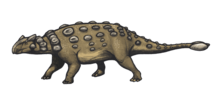Invictarx
Invictarx is a genus of herbivorous nodosaurid dinosaur from New Mexico dating from the early Campanian epoch of the Late Cretaceous.
| Invictarx | |
|---|---|
 | |
| Thoracic osteoderms of Invitarx zephyri (part of the holotype) | |
| Scientific classification | |
| Kingdom: | Animalia |
| Phylum: | Chordata |
| Clade: | Dinosauria |
| Order: | †Ornithischia |
| Family: | †Nodosauridae |
| Genus: | †Invictarx McDonald and Wolfe, 2018 |
| Type species | |
| †Invictarx zephyri McDonald and Wolfe, 2018 | |
Discovery and naming

In May 2011, Dan Williamson discovered a fragmentary ankylosaurian skeleton in San Juan County, New Mexico. In October 2011, nearby a second skeleton was found by Andrew T. McDonald, followed by the discovery of a third skeleton in October 2015 by Keith Brockmann.[1]
The holotype of Invictarx zephyri, specimen WSC 16505, consists of an incomplete postcranial skeleton found in 2015, including six complete or nearly complete osteoderms, a dorsal rib, and fragments of additional osteoderms.[1] The two other additional partial skeletons have been referred. Specimen UMNH VP 28350 consists of three dorsal vertebrae, the distal end of a left ulna, proximal ends of left and right radii, an incomplete metatarsal, and additional osteoderms. Specimen UMNH VP 28351, the first found, contains dorsal vertebrae and osteoderms.[1]
The name Invictarx means "invincible/unconquerable fortress", in reference to the fact that Invictarx, like all other ankylosaurs, was protected from predators by armor.[1] The specific name, zephyri, is the genitive form of the Latin noun zephyrus, meaning (of the) western wind, referring to the "blustery conditions that prevail among the outcrops where the specimens were discovered".[1]
Paleobiology
Invictarx was found in the upper part of the Allison Member of the Menefee Formation, which is of early Campanian age. Archosaurs that co-existed with Invictarx include the tyrannosaurid Dynamoterror dynastes, the alligatoroid Brachychampsa sealeyi, and an unnamed centrosaurine ceratopsid.[2][3][4]
References
- McDonald, A.T.; Wolfe, D.G. (2018). "A new nodosaurid ankylosaur (Dinosauria: Thyreophora) from the Upper Cretaceous Menefee Formation of New Mexico". PeerJ. 6: 6:e5435. doi:10.7717/peerj.5435. PMC 6110256. PMID 30155354.
- McDonald, A.T.; Wolfe, D.G.; Dooley Jr, A.C. (2018). "A new tyrannosaurid (Dinosauria: Theropoda) from the Upper Cretaceous Menefee Formation of New Mexico". PeerJ. 6: 6:e5749. doi:10.7717/peerj.5749. PMC 6183510. PMID 30324024.
- Williamson, TE (1996). "Brachychampsa sealeyi, sp. nov., (Crocodylia, Alligatoroidea) from the Upper Cretaceous (lower Campanian) Menefee Formation, northwestern New Mexico". Journal of Vertebrate Paleontology. 16 (3): 421–431. doi:10.1080/02724634.1996.10011331.
- Williamson TE. 1997. A new Late Cretaceous (early Campanian) vertebrate fauna from the Allison Member, Menefee Formation, San Juan Basin, New Mexico. In: Lucas SG, Estep JW, Williamson TE, Morgan GS, eds. New Mexico’s Fossil Record 1. Albuquerque: New Mexico Museum of Natural History and Science Bulletin 11. 51-59.

